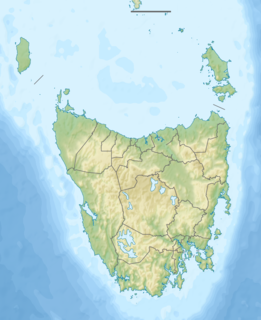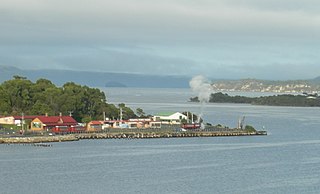
The Lake Margaret Tram was located on the western side of Mount Sedgwick in the West Coast Range on the West Coast of Tasmania in service for the Mount Lyell Mining and Railway Company to the Lake Margaret community. [1]

The Lake Margaret Tram was located on the western side of Mount Sedgwick in the West Coast Range on the West Coast of Tasmania in service for the Mount Lyell Mining and Railway Company to the Lake Margaret community. [1]


By 1903, the timber areas having been cut out around Queenstown itself, the wood cutters moved to Howard's Plains situated on the plateau north west of Queenstown. As access onto the plateau was steep, a self-acting 2 ft (610 mm) narrow gauge dual haulage was built. From the top of the incline, a tramway was laid and was extended, over a period of time, some 4¼ miles towards Lake Margaret. [1]
Following the decision to build the Lake Margaret Power Station, the Howard's Plains Tram was extended from its then terminus at the 4¼ mile peg. [2] Work commenced on the extension on 19 August 1912. The Howard's Plains tram was completely upgraded. The total distance from the haulage to the power station being 7 miles, including a zig zag along the line. [1]
Following the completion of the power station on 28 November 1914, the tram continued to provide firewood as well as a freight and passenger service for employees and their families living at the isolated settlement. A second power station was built a mile below the first station, in 1931, and was also linked by tramway. [1]
In 1937, the terminus of the line was moved from the top of the haulage to its junction with the Queenstown to Strahan road. The haulage being no longer required after the construction of that road. Upon completion of the road to Zeehan in 1941, the terminus was moved again, out to its junction with that road, approximately 3 miles from Queenstown. [1]
The Lake Margaret Tram remained the only connection to the Lake Margaret locality for a considerable part of the twentieth century. It was closed in 1964 when a road was constructed into the power station and the settlement. [1]

Initially, the tram was worked by Krauss locomotives, while in later years an Alfa Romeo petrol locomotive was used. Several rail cars worked the line and included a 'Riley' in earlier years, while a Vauxhaull rail car was used in the later years. [1]

In 1959, the Mount Lyell Mining and Railway Company purchased two 2-foot gauge diesel shunting locomotives, manufactured by Tulloch Limited of Rhodes, New South Wales. These were intended for surface working on their system of that gauge. They were powered with a Fordson 4-cylinder 40 hp. engine. The locomotive weighed 4.5 tons. [3] As shown in the accompanying photograph, one of these locomotives was put to use on the Lake Margaret Tram.
After the tramline's tracks were removed, part of the formation was opened to the public as a hiking trail. [4] However access to the Lake Margaret Power station was restricted for some considerable time.[ citation needed ]

Zeehan is a town on the west coast of Tasmania, Australia 139 kilometres (86 mi) south-west of Burnie. It is located north of Strahan, Tasmania and Queenstown, Tasmania.

The West Coast Range is a mountain range located in the West Coast region of Tasmania, Australia.

Regatta Point is the location of a port and rail terminus on Macquarie Harbour.

The Melba Line is a 1,067 mm narrow-gauge railway on the West Coast of Tasmania. The line was originally constructed as a private railway line named the Emu Bay Railway and was one of the longest-lasting and most successful private railway companies in Australia. While at present the line travels from Burnie to Melba Flats, it previously ran through to Zeehan carrying minerals and passengers as an essential service for the West Coast community.

Gormanston is a town in Tasmania on the slopes of Mount Owen, above the town of Queenstown in Tasmania's West Coast. At the 2016 Gormanston had a population of 17.

The North East Dundas Tramway (NEDT) was a 2 ft narrow gauge tramway on West Coast Tasmania that ran between Zeehan and Deep Lead. It was part of Tasmanian Government Railways. The world's first Garratt locomotives TGR K Class were used on the line, as were two G Class 0-4-2T engines built by Sharp-Stewart of Glasgow in 1896 and a massive 'J Class' 2-6-4-0T articulated locomotive manufactured by Hagans of Erfurt in 1900.

Mount Read is a mountain located in the West Coast region of Tasmania, Australia, and is at the north west edge of the West Coast Range.

The North Mount Lyell Railway was built to operate between the North Mount Lyell mine in West Coast Tasmania and Pillinger in the Kelly Basin of Macquarie Harbour.
The history of the Railways on the West Coast of Tasmania has fascinated enthusiasts from around the world, because of the combination of the harsh terrain in which the railways were created, and the unique nature of most of the lines.
The Strahan–Zeehan Railway, also known as the "Government Railway", was a railway from Strahan to Zeehan on the west coast of Tasmania.

The Wee Georgie Wood Railway is a 2 ft narrow gauge tourist tramway running from Tullah, on a 1.9 km (1.2 mi) short track by the edge of Lake Rosebery in the West Coast Municipality of Tasmania.
The Mount Dundas – Zeehan Railway was a railway line running 7 miles (11 km) from Dundas to Zeehan on the West Coast of Tasmania. It operated from 1892 until 1932, and the rails were removed in 1940.
The Emu Bay Railway was an Australian railway company. Listed on the Melbourne Stock Exchange, it operated the Melba Line on the West Coast of Tasmania from 1897 until 1998.

Zeehan railway station in Tasmania, was a major junction and railway yard for numerous different railway and tramway systems in western Tasmania in the town of Zeehan.
Williamsford, Tasmania is the location of a former mining community, south of Rosebery, Tasmania and on the western lower reaches of Mount Read.

The West Coast Wilderness Railway is a reconstruction of the Mount Lyell Mining and Railway Company railway in Tasmania between Queenstown and Regatta Point, Strahan. The railway is significant because of its Abt rack system to conquer the mountainous terrain through rainforest, with original locomotives still operating on the railway today. Now operating as a tourist experience with a focus on sharing the history of Tasmania's West Coast, the original railway began operations in 1897 as the only link between Queenstown and the port of Strahan.

The Hercules Haulage, also known as the Mount Read Haulage, the Hercules Tram and the Williamsford Haulage Line, was a self-acting 2 ft narrow gauge tramway on the side of Mount Read in Western Tasmania, that connected the Hercules Mine with Williamsford and then to the North East Dundas Tramway.
Lou Rae is a Tasmanian author and historian of the West Coast of Tasmania.
Zeehan Highway is a road between Zeehan and Queenstown in Western Tasmania.

The Magnet Tramway, often found referred to as the Magnet Tram, was a 2 ft gauge railway in north west Tasmania.It ran between Magnet Junction on the Guildford to Mount Bischoff railway line, and the Magnet mine.